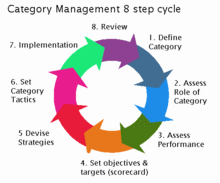I was recently invited to speak to the Board of FSMA on an issue that has them totally perplexed. FSMA is an organization of large food manufacturers and their agents which has been experiencing the following: longer sales cycles, lower margins, demand for additional services, challenges to prove their value add, etc., etc. And lo and behold – they thought they had found what was causing them all this angst – it was this new thing called Category Management (CM). For those of you not familiar with the retail sector, this is an integrated process to manage the entire lifecycle of a category of consumer goods. What it is not, is the category management (cm) process that people in sourcing and supply chain use. And this is where the confusion and tension arises.
The goals and objectives of CM are strategic in nature and try to maximize the value generated throughout the entire lifecycle of the category – a mini P&L if you will. Think of Product line organizations or business units with their P&L. The sourcing process or cm is a subset of the CM process. The needs of a particular category are developed in the CM process but are then funneled through the cm (sourcing) process to the suppliers. Let’s take a moment and think about that. The goal of the CM process is to maximize the profit from a category – the goal of the sourcing process is to find the lowest price supplier. The head of CM is measured on overall profit – the head of cm is measured on price savings.
Now imagine the suppliers caught in this vortex. They are constantly bombarded with the needs of CM where the head of CM is looking for tighter integration of their supply chain, supplier investments in Big Data projects so that they can do a better job of matching demand and supply, tracking effectivity of promotions, understanding consumer behavior better, etc., etc. Yet their interface to the buying organization is ultimately the sourcing process (cm). And the sourcing process is all geared towards reducing prices, managing TCO, lowering inventory levels, etc. While one can argue that the goals of the sourcing process enhance the profitability of the category by reducing price – they do so at the cost of sub-optimizing the overall profitability of the category. The poor supplier is being set up for failure. Supplier decisions and behaviors are therefore influenced far more by the sourcing process than they are by the CM process. No CM director has ever been fired for paying higher prices to suppliers while a sourcing manager may well lose their job for the same higher prices. Thus you have these somewhat competing processes with somewhat mis-aligned goals trying to influence the decisions and behaviors of the suppliers – no wonder they were all tearing their hair out at the FSMA BOD meeting.
Here is a description of the CM process from one of their major customers: “We are contributing to new product development, exclusive brands redesign and promotional activities, and helping extend XYZ’s leadership in innovation,” said Jody W., senior vice president, Category Management— Bakery, Beverage and Disposables. That sounds phenomenal and I would love to be a supplier jointly working with my customer and helping them in all of those goals. The customer goes on to say: “The Category Management team has also launched Strategic Vendor Management, a process for simplifying vendor relationships and streamlining the number of suppliers in each product category…….discussions with respect to assortment, pricing and promotion will be led by the team where we can leverage the buying power of a multibillion-dollar company versus 65 divisions buying individually.” Sound familiar?????
This dichotomy and tension between CM and cm needs to be acknowledged and recognized so that it can be resolved and aligned. If so, then all parties involved will benefit tremendously because everyone’s decisions and behaviors will be driven by the goals of CM. If not, then the poor suppliers will continue to spin in this vortex. There are many strategies and tactics that the suppliers have available to utilize that mis -alignment for their competitive advantage and actually gain market share and I shared a few of them with the audience. Ultimately, the goal of the suppliers is to get rid of that mis-alignment to force overall goal congruency. Till that happens, the title of this blog will stay accurate. When that happens, the title will become – Category Management!


4 Comments
Pingback: Another Meeting – Don’t Waste My Time . . . - News You Can Use
Pingback: Why Maturity Matters . . . . . . - News You Can Use
Pingback: Do You Know the Difference Between Strategic Sourcing and Category Management? - News You Can Use
Pingback: Strategic Sourcing vs. Category Management